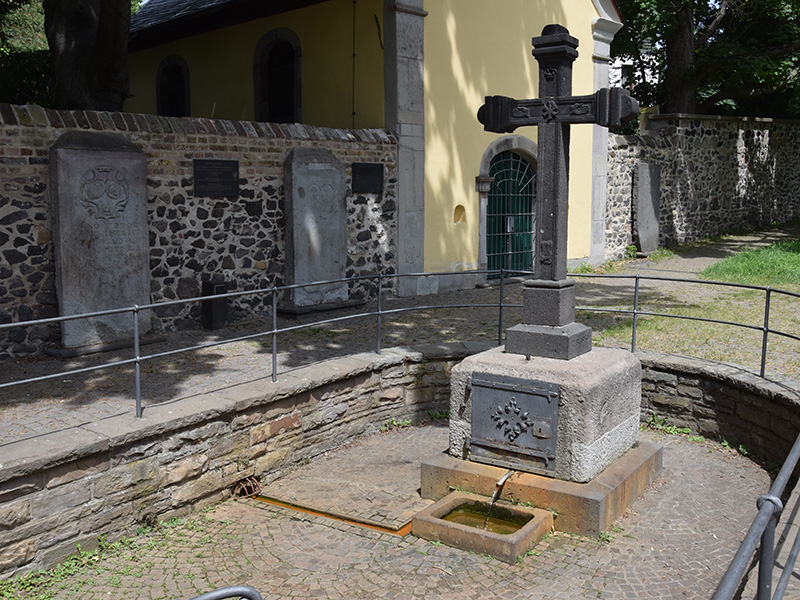
HISTORICAL INFORMATION ON THE ADELHEID FOUNTAIN
On this page you will find further information on the Adelheid Fountain from the Bonn-Rechtsrheinisch e.V. Monument and History Society.

Adelheid Fountain
From Adelheid to Pützchens Markt
"First we go to the Brünnchen and then to Pützchen" is the motto of many visitors to one of the largest public festivals far and wide: Pützchen's market. A little away from the hustle and bustle is a fountain in front of a chapel. Many people go there before or after the fair. The ritual includes a short pause, a prayer and a final washing of the eyes. But what is this custom all about?
It all began with a miracle
It was probably in the year 1005 when the Rhineland was exposed to a great drought and even the bed of the Rhine almost dried up. The people threatened by famine asked Adelheid, who was abbess of a monastery near Bonn, for advice. She is said to have prayed intensively with the people of the area and, according to legend, purposefully and with trust in God, thrust her abbess's staff into the earth and found a spring of water. This resulted in a "Pützchen", which warded off danger and still gushes today as the "Adelheidis-Brünnchen".
First to the Brünnchen and then to the market
After her death in 1015, the popularity of the Brünnchen rose with the veneration of Abbess Adelheid. The water was quickly attributed healing powers and attracted people from all over the region. A pilgrimage chapel and a monastery were built to look after the stream of pilgrims. Today, a visit to the water spring is a fixed ritual for many guests of Pützchens Markt. The alum-containing water is said to have healing properties, especially for eye complaints.
Puetzchen's market
Over the centuries, many people made pilgrimages to Adelheid's grave and the spring, through which many miracles are said to have occurred. To feed all these people, a market with food stalls, traders and jugglers was established in the middle of the 14th century. To this day, it has evolved into a modern, yet traditional, five-day fair that takes place annually on the market meadows and streets of Pützchen and attracts over a million visitors. Adelheid von Vilich was officially canonised by Pope Paul VI in 1966 and was made Bonn's second city patron saint in 2008.
Scientific assessment
In general, the groundwater in the area is up to twelve metres deep, but in some places aquifers lead just below the earth's surface. At the site of the spring on the northern slope of the Ennert mountain range, such a water-bearing aquifer runs above a clay layer in a north-westerly direction to the mouth of the Sieg River.[7] Punching through the top layer is possible.
According to legend, the spring supplies a larger number of people and animals, but this is not considered realistic. In a study in 2015, climatologist Karsten Brandt found that the spring only releases between six and seven litres of water per minute.
A medically provable effect of the water cannot be determined. The water probably comes from a basalt layer north of the Ennert and smells like rotten eggs. This smell is caused by the conversion of sulphate into sulphide, which produces hydrogen sulphide. It is not conducive to good health. A sign "No drinking water" is attached to the well.
Fountain and cross
In 1684, the fountain was created with a square, three-metre-deep basin. In 1694 it was given a baroque setting. In 1864, it was restored and the fountain and spring chamber were probably raised. In 1989, the complex was completely renovated.
A wayside cross standing above the spring chamber was also erected in 1684. It contained the founder's initials and a date from that year. It was destroyed during the Second World War and replaced by a wooden cross after the war. In 1959 it was restored in its old form. The cross is made of trachyte. It shows the stigmata of Christ in low relief, the arms of the cross end rounded and are each covered with two rings. The founder's initials H I W C P are executed in the font Capitalis monumentalis. When the church was rebuilt in 1959, the old form was chosen and the initials were adopted, but the year was omitted.
After Johann Ignaz Schmitz-Reinhart the inscription means
"H(ERZOG) I(OHANNES) W(ILHELMVS) C(OMES) P(ALATINVS)"
(Studies on the local history of the city of Beuel am Rhein)
The interpretation with the reference to Johann Wilhelm of Palatinate-Neuburg as the donor is controversial, as the initials in the interpretation contain a mixture of German and Latin expressions. On the other hand, it is certain that Johann Wilhelm, then Duke of Jülich and Berg, was the sovereign who had the Adelheidis fountain built when the Adelheidis pilgrimage increasingly moved from the saint's grave in Vilich to Pützchen.
The name Pützchen
The field designation and the later name of the district can be traced back to the Adelheidis spring. In Rhenish usage, the term Pütz refers to a spring; the term is based on the Latin word Putues (Well).
The first documentary mention of the village dates back to 1367, at that time without the name Pützchen: "bi sente Aleyde borne" (Adelheidisborn). The present name was first used in 1749 ("Adelheidis Pützgen").
Source: Catholic City Deanery of Bonn, Wikipedia
